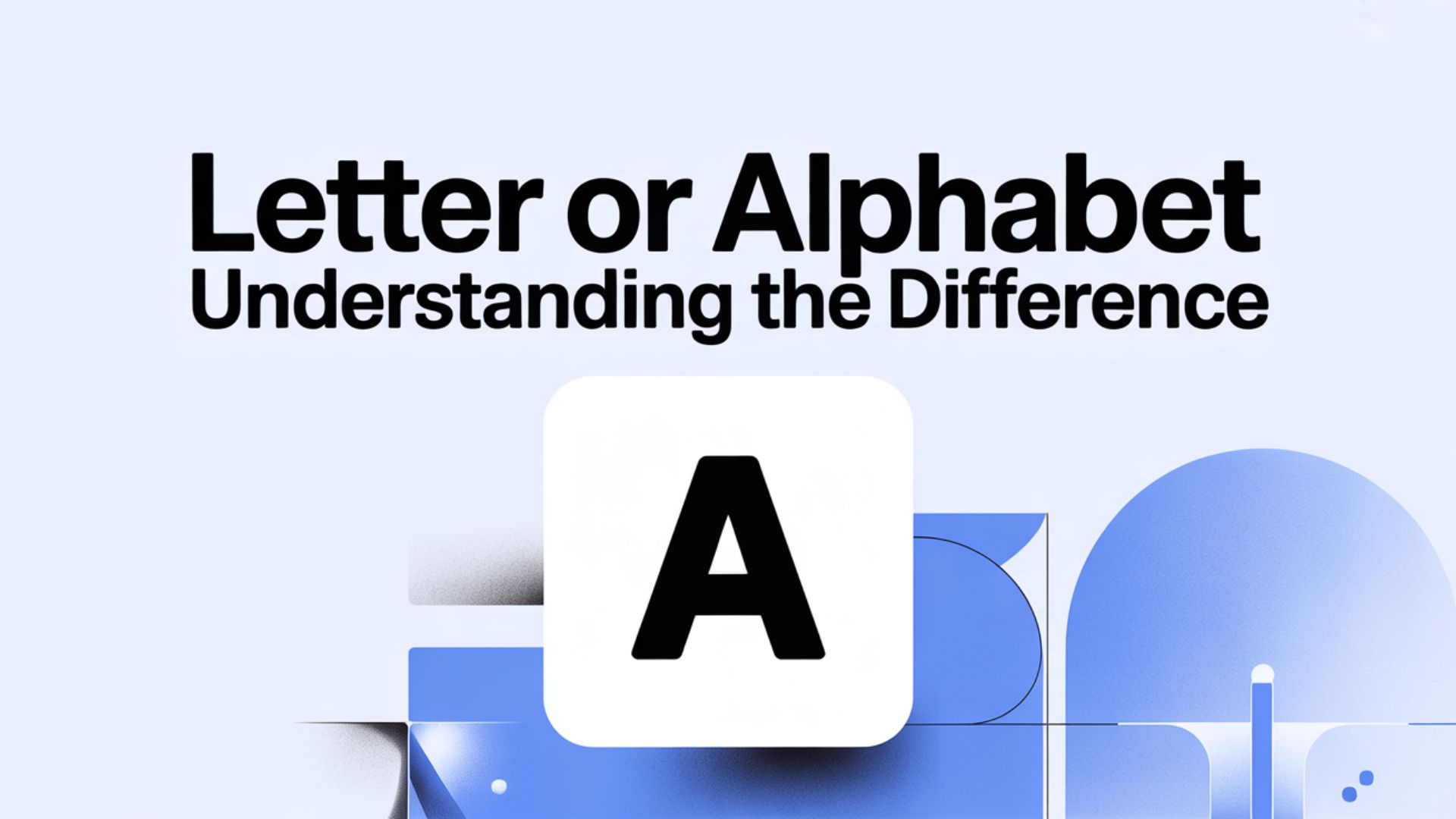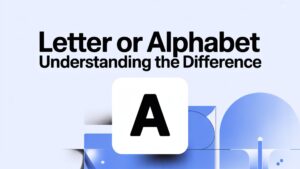The English language like every other language rests upon its smallest yet most crucial elements: letters and alphabets. These terms might seem interchangeable, but they carry distinct meanings. Writers, teachers, students, and even seasoned readers often confuse them.
To fully grasp the difference between letter and alphabet, you need to dig deeper into their history, usage, and role in writing and communication systems.
This article explores the meaning of letter in English, the meaning of alphabet in English, and how both function as the building blocks of language. Along the way, you’ll see examples, anecdotes, emails, and even tables that clarify the nuances.
What are Letters?
A Letter is a linguistic symbol used to represent a sound, or phoneme, in spoken language. Each letter carries symbolic meaning within a standardized writing system.
- Letters as symbols of sounds: In English, A, B, C, D, Z are letters. Each of these has its own name, shape, and associated phonetic representation in writing.
- Function of letters in words: Letters combine to form words. Without them, there’d be no vocabulary, no sentences, no literature.
- Role of letters in literacy: Children learning to read first memorize letters before understanding how they form words. This makes letters the true foundation of learning and education.
Scenario Example (Email):
Subject: Struggling with Spelling
Dear Mr. James,
I’ve noticed that my son David mixes up letters when writing words, especially confusing B and D. Could you suggest exercises to strengthen his grasp of the letters as symbols of sounds?
Thank you, Sarah Monroe
Here, Sarah highlights her child’s difficulty with letters, not alphabets. The issue lies in individual characters.
What are Alphabets?
An Alphabet refers to a set of letters in a language, arranged in a particular order—like alphabet order A to Z in English. Unlike a single letter, an alphabet is the complete collection of all letters within a writing system.
- Alphabet as writing system: The English alphabet (26 letters) includes everything from A to Z.
- Role of alphabets in communication: An alphabet provides a systematic framework for writing and ensures everyone follows the same sequence when spelling or organizing words.
- Cross-linguistic influence: The alphabet concept spread through history, thanks to the Phoenician script, the Greek alphabet, and the Latin writing system.
Scenario Example (Email):
Subject: Preparing Classroom Materials
Hi Rachel,
Could you please prepare a colorful poster of the English alphabet (26 letters) for the new students? Make sure the letters are shown in alphabet order A to Z.
Best, John Carter
In this case, John refers to the alphabet, the complete set of letters in a language, not an individual character.
Letter vs Alphabet: The Differences
Understanding the difference between alphabet and letter clarifies how language functions.
| Aspect | Letter | Alphabet |
|---|---|---|
| Definition | A single symbol representing a phoneme | A set of letters in a language |
| Example | A, B, C, D, Z | The English alphabet (26 letters) |
| Role | Building blocks of words | Provides a systematic framework for writing |
| Scope | Singular unit | Complete collection |
| Usage in literacy | Taught first to identify sounds | Memorized as an ordered structure |
| Connection to phonemes | Represents one phoneme or grapheme | Encompasses all letters used in a language |
- Difference between word and letter: A word is a meaningful unit formed by arranging letters. For example, the word “cat” is made from the letters C, A, and T.
- Words and letters difference: Letters on their own don’t convey meaning, but words do.
- Alphabet vs word difference: An alphabet is a structure, while a word is a product of arranging letters.
Scenario Example (Email):
Subject: Confusion Between Word and Letter
Dear Professor Allen,
My daughter keeps asking me the difference between word and letter. I explained that a word carries meaning, while a letter is just a symbol. Still, she finds it confusing. Could you recommend a book that simplifies the words and letters difference for children?
Regards, Mark Thompson
Origins of the Words “Letter” and “Alphabet”
Understanding the etymology of “letter” and “alphabet” deepens our knowledge of how these terms shaped language.
Origins of “Letter”
- From Old French (“letre”).
- Rooted in Latin (“littera”), meaning a written character.
- Traces back to Greek (“diphthera”), which meant “writing surface of parchment.”
- Related Old English terms: “ærendgewrit” (message or document), “stæfræw” (row of letters, alphabet), and “stæfrof” (letter arrangement).
The meaning of letter in English today still holds close ties to these roots: a single written or printed symbol.
Scenario Example (Epistle-like Writing):
Dearest Amelia,
In ancient times, a letter could mean a document / writing / epistle as much as a single character. Imagine how the word evolved from Old French “letre” and Latin “littera” to what we use today!
Yours, Edward
Origins of “Alphabet”
- From Greek (“alphabetos”), which combines the first two Greek letters: alpha and beta.
- Related to Greek “alpha” and “beta.”
- The concept spread through the Greek alphabet origin and influenced the Latin writing system.
- Earlier roots connect to the Phoenician script, considered the ancestor of many modern alphabets.
The meaning of alphabet in English today: a set of letters in a language.
Scenario Example (Historical Note):
Dear Colleagues,
When teaching about the Greek alphabet origin, don’t forget to mention how it borrowed heavily from the Phoenician script. That’s why the history of alphabets shows strong cross-linguistic influence (Greek, Latin, Old English, Phoenician).
Best, Dr. Harrison
A Final Look
To recap:
- A Letter is a symbol of a sound. Example: A, B, C, D, Z.
- An Alphabet is the complete set of letters in a language, such as the English alphabet (26 letters).
- The difference between letter and alphabet lies in scale: individual unit vs. structured collection.
- The difference between word and letter: words carry meaning, letters don’t.
- Both concepts are essential to language structure, spelling and phonetics, and written communication.
Think of letters as bricks, and the alphabet as the entire blueprint of a building. Without letters, you can’t make words; without alphabets, you can’t have a systematic framework for writing.









